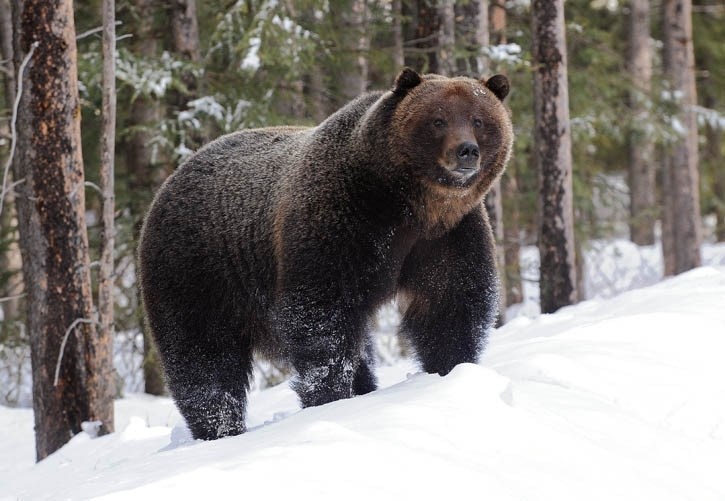Bear No. 122, aka The Boss, has emerged from his winter den, a tell-tale sign that spring is here and bear season begins.
Parks Canada confirmed Bear 122 was spotted on Monday (March 18) – the first confirmed grizzly sighting of the year in Banff National Park.
“Bears are awake and active in Banff National Park,” said Cassandra Smyth, public relations and communications officer, in an email.
“Bear activity will begin to increase within the national park, as spring arrives. “
Parks Canada would not provide an interview with the wildlife team.
With snow still on the ground, food is scarce when bears emerge from their dens in mid to late March to mid-May.
Lean and in need of nutrition, bears typically spend spring searching for food in the valley bottoms and don’t move to higher elevations until the snow disappears and vegetation greens up later in the season.
Bears will be roaming far and wide in search of food at this time of year.
To ensure the safety of wildlife and the public during this sensitive time of increased activity, Parks Canada area closures may be implemented as needed.
“Visitors and residents are reminded to be alert and show wildlife respect while recreating in Banff National Park,” said Smyth. "Wildlife encounters can happen at any time in Banff National Park.”
In the case of No. 122, he typically travels up and down the railway tracks as an easier way to move through the snowy environment, searching for spilled grain or the carcasses of other wildlife that were struck and killed by trains over winter.
For now, this bear and other bears that will be coming out of their dens are focused solely on finding food. Bear No. 122 remains successful as the dominant bear in the park, meaning he has bred with most of the female bears in the area and has access to the best food sources.
While his movements vary throughout his 2,500-square-kilometre home range in Banff National Park and potentially parts of Kootenay National Park, including frontcountry and backcountry areas, he spends the early part of the year in the busy Bow Valley.
The patriarch of Bow Valley grizzlies, The Boss is often the last grizzly to go into the den for winter and typically the first out.
Last year, the first sighting of him was on March 23 west of Banff along the Bow Valley Parkway.
In 2022, he appeared on March 14 and the year before that was March 29.
A Parks Canada resource conservation officer came across large bear tracks on Feb. 28, 2020 – the earliest a grizzly bear had been recorded out of the den in Banff over the previous decade. It was suspected to be No. 122.
A remote camera picked up an image of The Boss on March 19, 2019. In 2018, he was spotted March 24. In 2017, there was a confirmed sighting on March 22, in 2016 on March 5, in 2015 March 19 and in 2014 on March 16.
A regular in the Bow Valley, the celebrity bear is thought to be well over 20 years old.
Bear 122’s closest rival is bear No. 136, also known as Split Lip for his disfigured mouth. While his exact age is unknown, wildlife experts suspect bear 136 is approximately in the same age range too.
Following the emergence of the large male grizzly bears, sub-adults and adult females will be the next to come out of their dens. Females with cubs are typically the last out.
Parks Canada reminds residents and visitors to make lots of noise, stay on official trails and travel during daylight hours, while also considering hiking in larger groups.
There is also advice to watch for fresh bear signs – tracks, droppings, diggings, torn-up logs and turned-over rocks are all signs that a bear has been in the area.
“Leave the area if the signs are fresh,” said Smyth.
If hiking, and people come across a large dead animal, Parks suggests leaving the area immediately and reporting it to park staff and call Banff dispatch at 403-762-1470.
Residents and visitors are also reminded to carry bear spray, make sure it is accessible and know how to use it. Bear spray can help deter other large animals, too, such as cougars, wolves, coyotes, elk, deer, moose, and bison.
It is also the law to keep dogs on leash at all times in the national park.
“Dogs can provoke defensive behaviour in bears,” said Smyth.
In Yellowstone National Park, the first official sighting of a grizzly in 2024 was reported on March 3. It was spotted by skiers.



